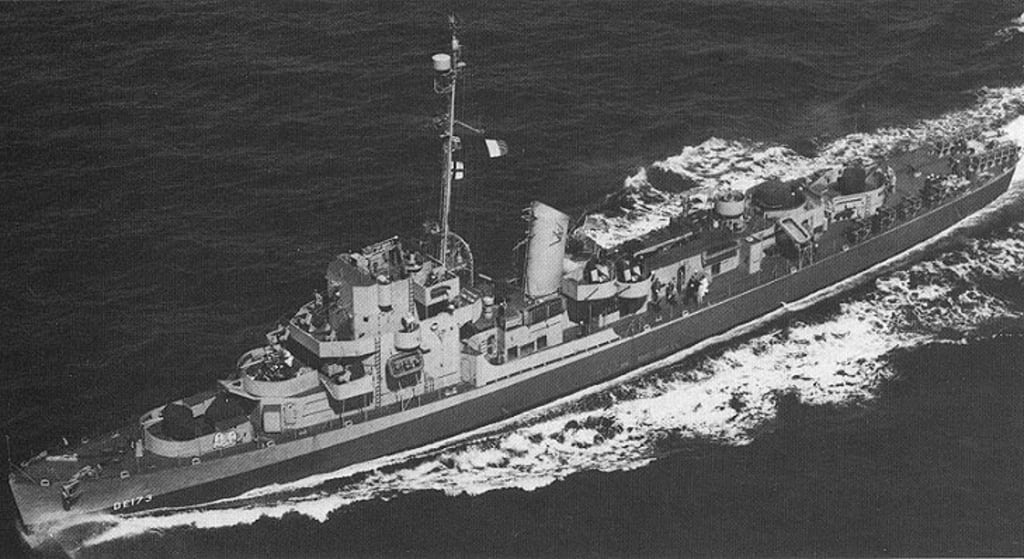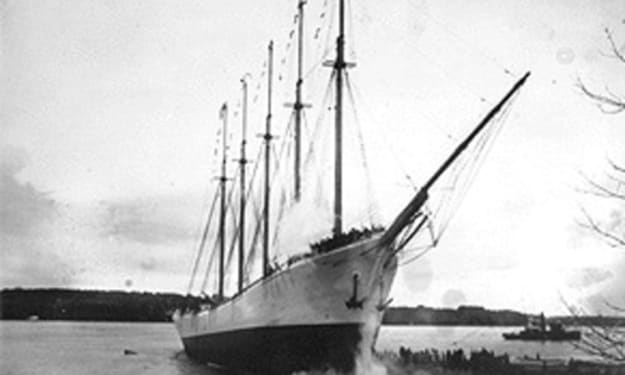Bending Reality: The Philadelphia Experiment
Did the US government really break the rules of physics?

Shady government programs, experiments gone wrong, reality-defying phenomenon - the story of the Philadelphia Experiment has all the markings of a sci-fi epic. Numerous articles and books have been written about it. There have even been Philadelphia Experiment movies. Whole corners of the internet have been devoted to it, and entire generations have speculated on whether it's true or not. So, what was the Philadelphia Experiment?
THE STORY
The Philadelphia Experiment was an alleged experiment whose official name was Project Rainbow, performed by the U.S. Navy on 28 October 1943 at the Philadelphia Naval Yard in Philadelphia, Pennsylvania. According to the story, the Navy was attempting to render the USS Eldridge invisible. Instead, the destroyer dematerialized and was teleported from Philadelphia to Norfolk, Virginia, and back again. The unfortunate crew that was aboard at the time allegedly suffered long-term side effects from their trip, including insanity and sporadic bouts of invisibility. These effects were supposedly so terrible that the Navy abandoned their line of research.
As the story goes, the experiment was done by a Dr. Franklin Reno and was supposedly an application of Einstein's unified field theory as it successfully demonstrated a connection between gravity and electromagnetism (what some have called electromagnetic space-time warping).
Testing allegedly began in the summer of 1943 and was successful to a limited degree. One test rendered the ship nearly invisible, with the area where the ship had been being developed in a greenish fog. Afterward, crew members complained of severe nausea. In some versions of the story, when the Eldridge reappeared, there were crew members who were embedded in the metal of the ship and others aboard went insane. At this point, the Navy changed its objective from rendering the ship completely invisible to merely rendering it invisible to radar.
The equipment was re-calibrated, but this was not done correctly and when the experiment was repeated on 28 October, the Eldridge not only became invisible but disappeared in a flash of blue light and appeared in Norfolk, Virginia, over 200 miles away. It sat in full view of those aboard the merchant ship SS Andrew Furuseth for some time before it vanished and then reappeared in Philadelphia where it had originally been. Some versions of the story say that it had also gone approximately 10 minutes back in time.
Stories of the side effects suffered by the crew of the Eldridge include some being physically fused to bulkheads, some developing mental disorders, some re-materializing inside out, and others not re-materializing at all. It has also been claimed that the surviving crew members were "brainwashed" into forgetting that the experiment had ever happened at all.
THE STORYTELLERS
In 1955, auto parts salesman and amateur astronomer Morris K. Jessup published The Case for the UFO, in which he speculated that anti-gravity and electromagnetism would be more effective means of propulsion for space vehicles than rocket fuel. The next year, Jessup began receiving letters from a man calling himself Carlos Miguel Allende. Allende's real name was Carl Allen and he was probably not the most stable individual.
Allen told Jessup of the Philadelphia Experiment, claiming that he witnessed the disappearance of the Eldridge while aboard the SS Andrew Furuseth. Allen also claimed, among other things, that he saw some Eldridge crew members disappear during a bar fight. This has turned into one of the more famous stories surrounding the experiment.
Allen sent an annotated copy of Jessup's book to the Office of Naval Research (ONR) in Washington, D.C., in which he had hand-written comments claiming knowledge of UFOs, their means of motion, and the culture of the beings occupying those UFOs, using pseudo-scientific and incoherent terms. The notes were in three different ink colors and written as three different characters, but were all in the same handwriting.
The ONR contacted Jessup to find out if he knew who had sent them the book and written the annotations. Jessup recognized Allen's handwriting and turned over all the letters had received from him. Later, the annotated book, along with Allen's letters, was published by the Varo Manufacturing Corporation, a firm that did research for the military. Unfortunately, Jessup committed suicide in 1959 and Allen continued sending strange annotations to relatives for years.
Believers and conspiracy theory advocates theorize that Allen was an actual witness, as he claimed, or is himself an alien and "channels" information. Some claim that the Navy is perpetuating a cover-up, and may even be working with extraterrestrials. The truth is that Allen made up the entire story. His hoax has turned into legend, the story sustained by the publication of both fiction and non-fiction books, television shows, and documentaries.
THE REALITY
Edward Dudgeon, a crewman on the USS Engstrom, spoke to UFO investigator Jacques Valle and claimed that while the Navy was, in fact, experimenting with "invisibility" in 1943, they were not trying to make the ships disappear. They were instead trying to make ships "invisible to magnetic torpedoes by de-Gaussing them" (Valle, 1994). Dudgeon described the procedure as involving wrapping the vessel in large cables and sending high voltages through the cables in an attempt to scramble the ship's magnetic signature. He said that the operation involved contract workers and that there were merchant ships around, so it was possible that civilian sailors could have heard Navy personnel saying something about making the ship "invisible."
According to Dudgeon, the Eldridge and the Engstrom were harbored together and the crews often socialized on shore. He claimed that he was one of the sailors that "disappeared" during a bar fight. He said the fight started when one sailor was bragging about secret equipment and was told to be quiet. Since Dudgeon and another sailor who was with him were minors, the waitresses sneaked them out the back when the fight started and later denied knowing about them to the authorities.
Also according to Dudgeon:
The Eldridge had already left at 11 p.m. Someone looking at the harbor that night might have noticed that the Eldridge wasn't there anymore and it did appear in Norfolk. It was back in Philadelphia harbor the next morning, which seems like an impossible feat. If you look at the map you'll see that merchant ships would have taken two days to make the trip. They would have required pilots to go around the submarine nets, the mines, and so on at the harbor entrances to the Atlantic. But the Navy used a special inland channel, the Chesapeake-Delaware Canal, that bypassed all that. We made the trip in about six hours." (Valle, 1994)
The Navy denies any such experiment was ever done. Despite numerous searches of the records in the Operational Archives Branch of the Naval Historical Center, no documentation confirming such an event as the supposed experiment has been located, nor has any evidence of the Navy's interest in attempting such a thing as invisibility been found. Operational Archives has reviewed the Eldridge's deck log and war diary from its commissioning on 27 August 1943 through to December 1943 and published the following summary of the ship's activities:
After commissioning, Eldridge remained in New York and in the Long Island Sound until 16 September when it sailed to Bermuda. From 18 September, the ship was in the vicinity of Bermuda undergoing training and sea trials until 15 October when Eldridge left in a convoy from New York where the convoy entered on 18 October. Eldridge remained in New York harbor until 1 November when it was part of the escort for Convoy UGS-23 (New York Section). On 2 November the convoy entered Naval Operating Base, Norfolk. On 3 November, Eldridge and Convoy UGS-23 left for Casablanca where it arrived on 22 November. On 29 November, Eldridge left as one of the escorts for Convoy GUS-22 and arrived with the convoy on 17 December at New York harbor. Eldridge remained in New York on availability training and in Block Island Sound until 31 December when it steamed to Norfolk with four other ships. During this time frame, Eldridge was never in Philadelphia.
Similarly, records show that the SS Andrew Furuseth, the civilian merchant ship that supposedly witnessed the arrival of the Eldridge via teleportation in the Norfolk area, was en route to Oran with Convoy UGS-22 on the date of the supposed experiment and did not return from the Mediterranean until 17 January 1944.
The ONR has stated that the claims of making a ship invisible do not conform to known physical laws. Einstein's unified field theory was never completed, and while he was a part-time consultant for the Navy's Bureau of Ordnance, doing theoretical research on explosives and explosions, there is no indication that he was involved in research relevant to invisibility or teleportation.
As for the code name of "Project Rainbow," no records have been found of a Project Rainbow relating to teleportation or invisibility of any kind. During the 1940s, the code name RAINBOW was used to refer to the Rome-Berlin-Tokyo axis and RAINBOW plans were the war plans to defeat Italy, Germany, and Japan.
According to the Department of the Navy, degaussing is "a process in which a system of electrical cables are installed around the circumference of a ship's hull, running from bow to stern on both sides. A measured electrical current is passed through these cables to cancel out the ship's magnetic field. Degaussing equipment was installed in the hull of Navy ships and could be turned on whatever the ship was in waters that might contain magnetic mines, usually shallow waters in combat areas" (Department of the Navy, 2000). While this makes the ship "invisible," in a way, to the sensors of magnetic mines, it does not make the ship invisible to the naked eye, radar, or hydrophones, and certainly has nothing to do with teleportation.
There is no evidence that the story of the Philadelphia Experiment is anything but a hoax perpetuated, intentionally or not, by a disturbed individual that took on a life of its own and gained urban legend status.
SOURCES
Department of the Navy - Naval History & Heritage Command (2000, Nov. 28). The "Philadelphia experiment". Retrieved from http://history.navy.mil/faqs/faq21-1.html
Department of the Navy - Office of Naval Research (1996, Sept. 08). Information Sheet: Philadelphia Experiment. Retrieved from http://www.history.navy.mil/research/library/online-reading-room/title-list-alphabetically/p/philadelphia-experiment/philadelphia-experiment-onr-info-sheet.html
Dunning, B. (2006, Dec. 24). The real Philadelphia experiment. Skeptoid Podcast, Skeptoid Media. Retrieved from http://skeptoid.com/episodes/4016
Durham, R.B. (2015). Modern folklore. CreateSpace Independent Publishing Platform. ISBN 978-1517785390
The Skeptic's Dictionary (2015, Nov. 21). Philadelphia experiment. Retrieved from skepdic.com/philadel.html
Valle, J.F. (1994). Anatomy of a hoax: The Philadelphia experiment fifty years later. Journal of Scientific Exploration, 8(1), pp. 47-71. Retrieved from http://www.scientificexploration.org/journal/volume-8-number-1-1994
About the Creator
B. Jessee
Appalachian writer & nerd. Writes about the strangest bits of history and science as well as science news.
Enjoyed the story? Support the Creator.
Subscribe for free to receive all their stories in your feed. You could also pledge your support or give them a one-off tip, letting them know you appreciate their work.






Comments
There are no comments for this story
Be the first to respond and start the conversation.